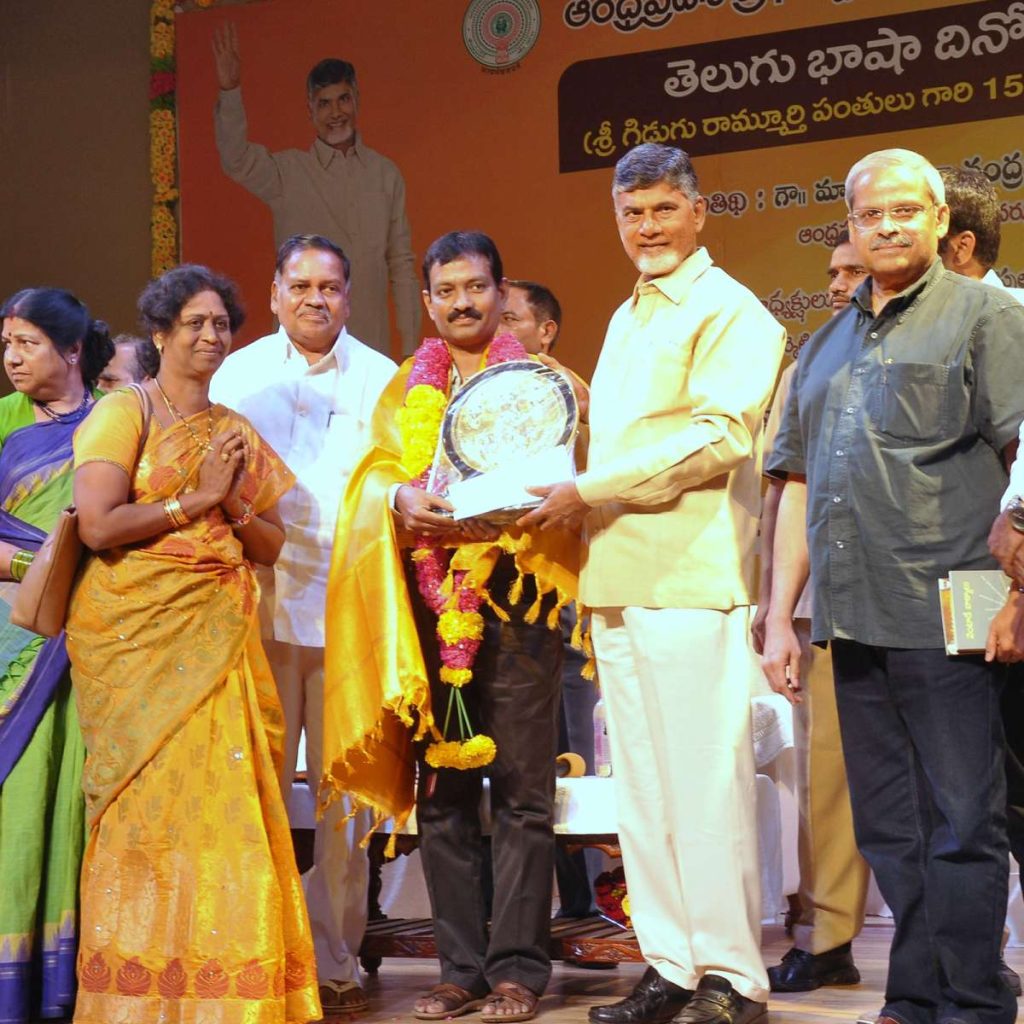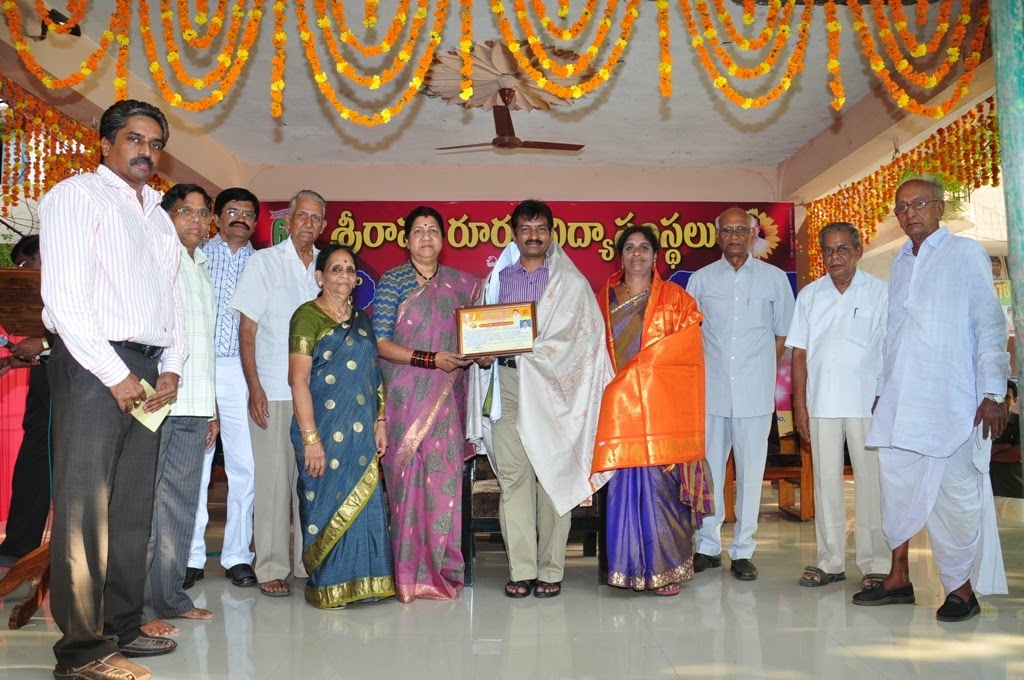Fostering Imagination and Shaping Society: A Journey through the World of Children’s Stories
Today, as we commemorate Uncle Pai’s birthday, we celebrate his enduring dedication to education and his unwavering belief in the transformative power of storytelling for learning and enlightenment
On this special occasion, Khushboo Agrahari had the privilege of interviewing one of the eminent storyteller from Andhra Pradesh, Naramsetti Umamaheswara Rao. With a prolific output of over 1500 stories catering to both children and adults, Rao has left an indelible mark on the world of literature. He has authored more than 30 books and garnered numerous prestigious awards for his literary contributions and storytelling prowess.

Notably, Rao was honored with the esteemed Kendra Sahitya Akademi award in children’s literature for his novel “Ananda Lokam,” among other accolades. In recognition of his profound impact on the realm of children’s literature, Sri Jagana Sarathbabu received a doctorate from Andhra University, Visakhapatnam in 2022 for his extensive research on Rao’s works. Additionally, two scholars from Presidency College, Chennai were awarded M.Phil. degrees for their in-depth studies on various books authored by Naramsetti Umamaheswara Rao in 2016 and 2017.
Today, on Uncle Pai’s birthday, we bring you insights from this illustrious storyteller. Here are the edited excerpts from the interview.
Stories play a vital role in the growth and development of children. The books they read and the characters they get to know can become like friends. How do you choose your characters for your short stories?
“Albert Einstein once stated that stories are the key to nurturing a child’s intelligence. He believed that the tales children hear during their early years profoundly shape their personalities and cognitive development. These stories, told in their native language by parents and caregivers, not only bring joy but also impart vocabulary and moral values.
Children’s love for stories endures, enhancing their learning abilities and comprehension skills. Through characters in stories, they learn to discern right from wrong and internalize valuable life lessons. As they grow, school introduces them to a wider array of stories, deepening their empathy and understanding of human nature.

In crafting children’s stories, I carefully design characters to convey specific messages effectively. Relatable protagonists engage young readers and enhance their reading skills. Stories play a pivotal role alongside parents, teachers, and friends in shaping a child’s development.
Fiction based on real-life can also help children with their own life experience – it shows them how diverse the world is and that some people’s lives are vastly different to theirs. What themes you choose for kids.
The term you mentioned, “fiction based on real life,” raises questions about fiction itself. What exactly is fiction? If we narrate events from our lives that never occurred, it becomes fiction. While it might be fictional in our context, it could be someone else’s reality. This highlights how even fictional stories mirror real life. Only those stories rooted in reality truly touch readers’ hearts, captivating them and inspiring transformation.
Furthermore, hearing stories from others’ lives, even if they don’t mirror our own, unveils life’s myriad contradictions. These stories offer lessons in ethics, norms, cultures, and methodologies distinct from our own. This variety in life experiences enriches our understanding and consciousness, reminding us that life’s pathways diverge. By exposing children to diverse life stories, we impart education and illustrate the world’s vibrant tapestry. My selection of stories is tailored to the prevailing times. Yet, the ultimate objective remains instilling positive virtues in children through a protagonist devoted to societal well-being. Regardless of the plot, my guiding principle is always to craft stories that yield benefits for children’s growth.
Stories help to develop a child’s imagination by introducing new ideas into their world – ideas about fantastical worlds, other planets, different points in time and invented characters. How do you think writers help in the development of imagination in kids?
Children’s imagination is a potent force that constructs their unique worlds. Within these imaginative realms, they find solace with kindred spirits. Exploring such imaginative domains equips them with insights into reality, shaping their personalities and growth. The significance of children’s literature lies in nurturing this imagination, expanding their imaginative landscapes through stories.
My four-decade literary journey, from “Melerigina Manishi” to “Vintha jalam,” has been dedicated to enhancing children’s imaginative horizons. Children love conjuring magical worlds, populated by fantastical beings and characters. Trees, birds, and humans play versatile roles in these mental landscapes, contributing to their rich creativity.
Classic works like Panchatantra and Aesop’s fables teach children ethics and virtues through imaginative animal characters. Authors universally aim to ignite children’s imagination, fostering a deep connection to these fictional realms. The more vibrant and engaging this imaginative world, the more children wholeheartedly embrace it.

As you can see, children’s stories are important for a number of reasons and form a vital part of the growing process. Being part of that process do you think can writers help brings a sense of satisfaction as well as being great fun for children in the digital age?
In the digital era dominated by computers, time flows continuously, yet children’s imagination and joys remain steadfast. These enduring aspects remain constant regardless of changing times. Childhood remains unchanged, preserving its essence even as the world evolves. Children’s imagination, joys, and needs remain consistent. Our responsibility is to provide for children within the current societal context. Just as a mother’s love endures, so do the timeless joys of childhood. Children’s literature plays a pivotal role, captivating both young and old with stories. Life itself is a narrative, every human experience a story, every lesson a tale. Despite the digital age, children’s needs endure, met through books, videos, and technology that carry on the tradition of storytelling. Writers continue to play an essential role, weaving stories that shape society. Stories persist, fueled by the constant need for storytellers.
Chandamama, the magazine that taught generations about ethics and India for more than six decades. Being a writer from that golden era do you think today’s generation kids are missing the priceless treasure trove of stories from age old Indian tales?
Indeed, today’s children are missing out on the invaluable wealth of Indian stories. It’s not a lack of treasure but rather a shortage of proper conduits for it. Esteemed children’s magazines like Chandamama, Bommarillu, Bala, Balamitra, Balajyoti, Bala Bharti, and Bujjai have made a unique contribution to society and literature. Chandamama, in particular, stands as a symbol of children’s imagination, shaping lives profoundly. The cherished inclinations fostered by magazines like Chandamama have profoundly influenced generations, instilling language, culture, intelligence, and virtues. The era when Chandamama thrived marked a golden age of literature. However, the contemporary generation is missing out due to shifting times. Regular monthly magazines like Balabata, Molaka, Champak, and Nani are published, adapting to modern times through online platforms like Go Telugu.com, Sanchika, Kahaniya.com, and Pratilipi. While literature endures, the challenge lies in finding dedicated providers. Creators abound, but the lack of effective dissemination hampers access. Neglecting children’s literature in the current generation could lead to detrimental consequences for society.
We belong to the land of colourful tales that reflect a legacy steeped in rich imagination and limitless creativity of the mind. Our childhood is stored in comics and cartoons, be it for the sake of entertainment or implicit moral guidance. Do you agree that today’s literacy space is more or less westernizing?
Westernization hasn’t diminished children’s literature; if anything, it could have enhanced it. Our own childhood was a different era, while today’s childhood boasts technological advancement and expanded literary connections globally. In the past, entertainment options were limited, contrasting with today’s colorful, imaginative stories that stimulate creativity and reflect morals. Comics, then and now, play a role, though their presence is less in our Telugu language. Children are drawn to comics and cartoons, which wield significant influence, often exceeding that of books. Both mediums offer entertainment and development, carrying implicit moral messages. I firmly believe that children’s literature can thrive across diverse mediums.
Before the advent of a century driven by technology, the internet and artificial intelligence, when life did not oscillate between deadlines and computer screens, children were initiated into the world of vivid narratives and stories through numerous children’s magazines which introduced children to their fantastical and exceptional culture and mythology. Tell us the importance of literature and storytelling in today’s age?
In this era defined by internet and artificial intelligence, progress and civilization intertwine with technology. Our quality of life is gauged by our resources, which have advanced considerably. The sky is now traversable, planets reachable, and countless marvels created—a testament to technological growth. We present these developments as stories to children, expanding their imaginative realms, often leading to scientific discoveries. Children’s literature nurtures these imaginative sparks. Education and science, inescapable aspects of adulthood, stem from childhood. Our rich culture, though somewhat obscured, still harbors uniqueness derived from an array of unearthed civilizations. Understanding our culture is vital for a promising future.
Childhood magazines have long conveyed the magnificence of our culture. A diverse array of stories, from folk metaphors to multi-genres, spread across the nation, celebrating our culture. Preserving this culture for future generations is essential. We need profound narratives that divulge hidden truths and imagination.
Stories play an integral role in this process. Thus, passing down ancient texts like Puranas, Vedas, and Shastras is vital. Reading Ramayana imparts values like brotherly love, commitment, and loyalty. Bharata teaches against jealousy and recklessness, while Bhagavatam stresses on helping others. Ganesha’s story teaches respect for elders. Mythological stories should be introduced in childhood, nurturing the foundation for a brilliant future. As tools evolve, the joy remains unchanged—a nostalgic parallel between our childhood winged horses and today’s helicopter rides.
Telugu literature flowered in the early 16th century under the Vijayanagar empire, of which Telugu was the court language. Tell us a brief history of Telugu literature being an established Telugu writer?
Telugu literature thrived during the 16th century in the Vijayanagara Empire, marking a golden era. Poets penned numerous works, leaving a rich legacy for posterity. While this history is known, I believe our researchers have not fully explored the depths of Telugu’s antiquity. Andhras are mentioned in the Mahabharata, implying their ancient prominence. It’s likely that the Andhra language experienced substantial literary growth during that era. The Telugu Prabandha era, flourishing under the Vijayanagara Empire, is also significant in literature. We recently commemorated the millennium of the first poet, Nannayya, referring to it as a thousand years of Telugu. The Telugu we use today is influenced by Sanskrit and other languages, yet it’s crucial that we safeguard its distinct identity. Reviving forgotten Telugu words can reinvigorate the language, reestablishing its popularity and vibrancy. Losing a language means losing a significant part of our history, stunting development and life’s richness.
Stories have always been the lens through which children see the world, because stories highlight diversity, break gender stereotypes and define a moral compass for the society ! How do you choose your story idea?
Stories serve as moral compasses, offering a lens through which children perceive the world, guiding them towards exemplar behavior. They illustrate ideals, reflecting both nature and distortion. Stories hold an inherent idealism, subject to interpretation by each reader, shifting with age and perspective. Variations emerge from writers’ viewpoints, narrative styles, and intentions, enabling fresh insights even into familiar themes. This diversity maintains the writer-reader connection, acknowledging the need for variety.
As an author, I strive for narrative variety. Drawing from ancient and modern literature, I tailor stories to fulfill children’s needs while addressing common challenges they face. Writers carry the responsibility to reinvigorate ancient folk tales in a manner that resonates eternally, fostering social awareness.
Stories have the power to change the world for the better or worse. It is difficult to say where the line between fiction and fact is. We are witnessing, for example, how a story written by Valmiki is changing modern India for the worse. Even the Supreme Court believes the story to be fact, not fiction. What are your views?
Researchers aim to discern the authenticity of the Ramayana epic. Rather than fixating on its reality, the focus should be on the lessons, ethics, and societal benefits that this millennia-old narrative carries. Ramayana, a grand epic, holds virtues embedded in each character. Its status as fiction or reality is secondary. Every religion offers its holy texts, emphasizing goodness. The presence of facts or fiction doesn’t diminish the essence of goodness. Human nature encompasses both positive and negative traits, and we must extract only the good.
Literature isn’t exclusively history, and not all history is literature. Shastra texts, Puranas, and commentaries diverge. Regardless, the social benefits within them must be acknowledged. Ramayana’s creative brilliance is evident, inspiring new creations. Reading Valmiki’s Ramayana can empower writers. The characters exemplify noble qualities. While various interpretations exist, Valmiki’s version is often considered the standard. Literary exploration doesn’t always require absolute truth; it seeks good for society. Stories possess transformative power, whether constructive or not. Constant exposure can lead common people to view them as truths, blurring the line between fiction and reality. The Ramayana, embraced as a guide by many, influences lives across India, transcending religious faith.

There are growing instances of intolerance seen in our society today and its impact on the artistes and writers can be widely seen. Does it make telling your truth through your work all the more important? What keeps you going as a writer?
Social intolerances are complex and distressing, disrupting societal harmony. In a diverse nation like India, religious tolerance is paramount. Mutual respect should prevail without imposing beliefs on one another. No religion holds superiority over another. These issues also often intertwine with politics. Writers can contribute positively by reducing intolerance rather than exacerbating it. Artists employed by companies might find it challenging to express their full creativity. As writers, they may struggle to fulfill their social responsibility effectively.
Writers should strive to provide valuable insights to society without fueling conflicts. Balancing one’s work with the greater good is essential. Maintaining truthfulness is important, even if it means abstaining from writing at times. As a writer, my motivation stems from inner peace, self-assurance, and a sense of purpose. My life’s objective is social harmony. In this pursuit, I offer my dedication: Sangam Sharanam Gatchami!
ALSO READ-An Unmatched Adventure – A short story by Dubai based young aspiring author Myra Kumar
READ MORE-The art of story telling








